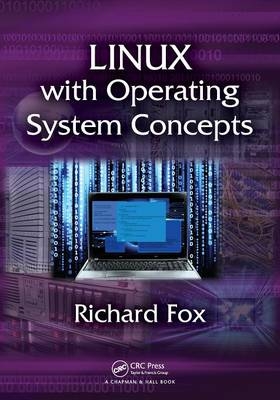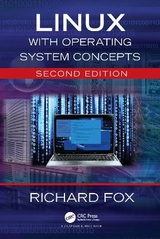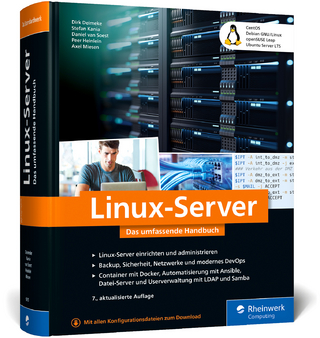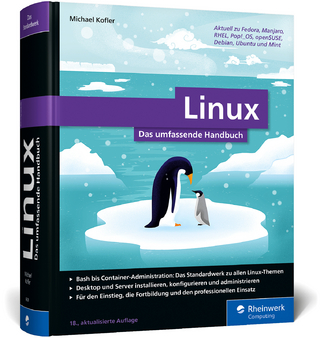
Linux with Operating System Concepts
Apple Academic Press Inc. (Verlag)
978-1-4822-3589-0 (ISBN)
- Titel erscheint in neuer Auflage
- Artikel merken
Linux with Operating System Concepts merges conceptual operating system (OS) and Unix/Linux topics into one cohesive textbook for undergraduate students. The book can be used for a one- or two-semester course on Linux or Unix. It is complete with review sections, problems, definitions, concepts, and relevant introductory material, such as binary and Boolean logic, OS kernels, and the role of the CPU and memory hierarchy.
Details for Introductory and Advanced Users
The book covers Linux from both the user and system administrator positions. From a user perspective, it emphasizes command line interaction. From a system administrator perspective, the text reinforces shell scripting with examples of administration scripts that support the automation of administrator tasks.
Thorough Coverage of Concepts and Linux Commands
The author incorporates OS concepts not found in most Linux/Unix textbooks, including kernels, file systems, storage devices, virtual memory, and process management. He also introduces computer science topics, such as computer networks and TCP/IP, binary numbers and Boolean logic, encryption, and the GNUs C compiler. In addition, the text discusses disaster recovery planning, booting, and Internet servers.
Introduction to Linux
Why Linux?
Operating Systems
The Linux Operating System: GUIs
The Linux Command Line
Virtual Machines
Unix and Linux
Types of Users
What Is a Computer?
This Textbook
The Bash Shell
Introduction
Entering Linux Commands
Man Pages
Bash Features
Other Shells
Interpreters
Navigating the Linux File System
Introduction
Filename Specification
File System Commands
Locating Files
Permissions
Linux File System Structure
Secondary Storage Devices
File Compression
Managing Processes
Introduction
Forms of Process Management
Starting, Pausing, and Resuming Processes
Monitoring Processes
Managing Linux Processes
Killing Processes
Linux Applications
Introduction
Text Editors
Productivity Software
LaTeX
Encryption Software
Email Programs
Network Software
Regular Expressions
Introduction
Metacharacters
Examples
grep
Sed
awk
Shell Scripting
Introduction
Simple Scripting
Variables, Assignments, and Parameters
Input and Output
Selection Statements
Loops
Arrays
String Manipulation
Functions
C-shell Scripting
Installing Linux
Introduction
The Linux Operating System
Installing CentOS 6
Installing Ubuntu
Software Installation Choices
Virtual Memory
Setting Up Network Connectivity and a Printer
SELinux
User Accounts
Introduction
Creating Accounts and Groups
Managing Users and Groups
Passwords
PAM
Establishing Common User Resources
The sudo Command
Establishing User and Group Policies
The Linux File System
Introduction
Storage Access
Files
Partitions
Linux Top-Level Directories Revisited
Other System Administration Duties
System Initialization and Services
Introduction
Boot Process
Boot Loading in Linux
Initialization of the Linux Operating System
Linux Services
Configuring Services through GUI Tools
Configuring Services through Configuration Files
Network Configuration
Introduction
Computer Networks and TCP/IP
Network Services and Files
Obtaining IP Addresses
Network Programs
The Linux Firewall
Writing Your Own Network Scripts
Software Installation and Maintenance
Introduction
Software Installation Questions
Installing Software from a GUI
Installation from Package Manager
Installation of Source Code
The gcc Compiler
Software Maintenance
The Open Source Movement
Maintaining and Troubleshooting Linux
Introduction
Backups and File System Integrity
Task Scheduling
System Monitoring
Log Files
Disaster Planning and Recovery
Troubleshooting
Bibliography
Appendix: Binary and Boolean Logic
Index
Chapter Review and Review Questions appear at the end of each chapter.
| Erscheint lt. Verlag | 7.10.2014 |
|---|---|
| Zusatzinfo | 79 Tables, black and white; 108 Illustrations, black and white |
| Verlagsort | Oakville |
| Sprache | englisch |
| Maße | 178 x 254 mm |
| Gewicht | 1247 g |
| Themenwelt | Informatik ► Betriebssysteme / Server ► Unix / Linux |
| Mathematik / Informatik ► Informatik ► Theorie / Studium | |
| Mathematik / Informatik ► Mathematik | |
| ISBN-10 | 1-4822-3589-7 / 1482235897 |
| ISBN-13 | 978-1-4822-3589-0 / 9781482235890 |
| Zustand | Neuware |
| Informationen gemäß Produktsicherheitsverordnung (GPSR) | |
| Haben Sie eine Frage zum Produkt? |
aus dem Bereich



